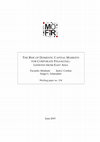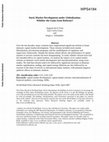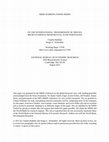Papers by Sergio Schmukler

Social Science Research Network, 1999
Peria and Schmukler examine the banking industries of small insured depositorswho punish risky ba... more Peria and Schmukler examine the banking industries of small insured depositorswho punish risky banks by Argentina, Chile, and Mexico to see if market discipline withdrawing their deposits. existed there in the 1980s and 1990s. Standardized coefficients and variance decomposition Using a set of bank panel data, they test for the of deposits indicate that bank fundamentals are at least as presence of market discipline by studying whether important as other factors affecting deposits. depositors punish risky banks by withdrawing their GMM estimates confirm that the results are robust to deposits. the potential endogeneity of bank fundamentals. They find that across countries and across deposit insurance schemes, market discipline exists even among This papera joint product of Finance, Development Research Group and the Office of the Chief Economist, Latin America and Carribean Region-is part of a larger effort in the Bank to study banking issues affecting developing countries.
The Policy Research Working Paper Series disseminates the findings of work in progress to encoura... more The Policy Research Working Paper Series disseminates the findings of work in progress to encourage the exchange of ideas about development issues. An objective of the series is to get the findings out quickly, even if the presentations are less than fully polished. The papers carry the names of the authors and should be cited accordingly. The findings, interpretations, and conclusions expressed in this paper are entirely those of the authors. They do not necessarily represent the views of the International Bank for Reconstruction and Development/World Bank and its affiliated organizations, or those of the Executive Directors of the World Bank or the governments they represent.

The World Bank eBooks, Mar 25, 2002
Hard pegs, such as currency boards, intend to reduce or even eliminate currency risk. This paper ... more Hard pegs, such as currency boards, intend to reduce or even eliminate currency risk. This paper investigates the patterns and determinants of the currency risk premium in two currency boards-Argentina and Hong Kong. Despite the presumed rigidity of currency boards, the currency premium is almost always positive and at times very large. Its term structure is usually upward sloping, but flattens out or even becomes inverted at times of turbulence. Currency premia differ across markets. The forward discount typically exceeds the currency premium derived from interbank rates, particularly during crisis times. The large magnitude of these cross-market differences can be the consequence of unexploited arbitrage opportunities, market segmentation, or other risks embedded in typical measures of currency risk. The premium and its term structure depend on domestic and global factors, related to devaluation expectations and risk perceptions.

The World Bank eBooks, Feb 12, 2007
Three main features characterize the international financial integration of China and India. Firs... more Three main features characterize the international financial integration of China and India. First, while only having a small global share of privately-held external assets and liabilities (with the exception of China's FDI liabilities), these countries are large holders of official reserves. Second, their international balance sheets are highly asymmetric: both are "short equity, long debt." Third, China and India have improved their net external positions over the last decade although, based on their income level, neoclassical models would predict them to be net borrowers. Domestic financial developments and policies seem essential in understanding these patterns of integration. These include financial liberalization and exchange rate policies; domestic financial sector policies; and the impact of financial reform on savings and investment rates. Changes in these factors will affect the international financial integration of China and India (through shifts in capital flows and asset/liability holdings) and, consequently, the international financial system.
The World Bank eBooks, Nov 20, 2003
Financial crises affect income distribution via different channels. In this paper, we argue that ... more Financial crises affect income distribution via different channels. In this paper, we argue that financial transfers are an important channel, which has been overlooked by the literature. We study the role of financial transfers by analyzing some of the most severe Latin American crises during the last decades (
World Bank, Washington, DC eBooks, Jul 18, 2023
Elsevier eBooks, Sep 1, 2017
The Policy Research Working Paper Series disseminates the findings of work in progress to encoura... more The Policy Research Working Paper Series disseminates the findings of work in progress to encourage the exchange of ideas about development issues. An objective of the series is to get the findings out quickly, even if the presentations are less than fully polished. The papers carry the names of the authors and should be cited accordingly. The findings, interpretations, and conclusions expressed in this paper are entirely those of the authors. They do not necessarily represent the views of the International Bank for Reconstruction and Development/World Bank and its affiliated organizations, or those of the Executive Directors of the World Bank or the governments they represent.
Washington, DC: World Bank eBooks, Jul 5, 2017
The Policy Research Working Paper Series disseminates the findings of work in progress to encoura... more The Policy Research Working Paper Series disseminates the findings of work in progress to encourage the exchange of ideas about development issues. An objective of the series is to get the findings out quickly, even if the presentations are less than fully polished. The papers carry the names of the authors and should be cited accordingly. The findings, interpretations, and conclusions expressed in this paper are entirely those of the authors. They do not necessarily represent the views of the International Bank for Reconstruction and Development/World Bank and its affiliated organizations, or those of the Executive Directors of the World Bank or the governments they represent.
World Bank, Washington, DC eBooks, Sep 1, 2017
The Policy Research Working Paper Series disseminates the findings of work in progress to encoura... more The Policy Research Working Paper Series disseminates the findings of work in progress to encourage the exchange of ideas about development issues. An objective of the series is to get the findings out quickly, even if the presentations are less than fully polished. The papers carry the names of the authors and should be cited accordingly. The findings, interpretations, and conclusions expressed in this paper are entirely those of the authors. They do not necessarily represent the views of the International Bank for Reconstruction and Development/World Bank and its affiliated organizations, or those of the Executive Directors of the World Bank or the governments they represent.

The World Bank eBooks, Sep 1, 2012
This paper provides the first comprehensive documentation of the main features of corporate bond ... more This paper provides the first comprehensive documentation of the main features of corporate bond issues in domestic and international markets and analyzes how firms use these markets after they internationalize. We find that debt issues in domestic and international bond markets have different characteristics, not explained by differences across firms or their country of origin. International issues tend to be larger, of shorter maturity, denominated in foreign currency, and include a higher fraction of fixed rate contracts. Moreover, a large proportion of firms remain active in domestic bond markets after accessing international markets, and many of these firms use both markets for different types of issues. This evidence suggests that domestic and international bond markets provide different financial services and are not substitutes, but but rather complements.

Journal of Banking and Finance, 2021
During the past decades, firms from emerging economies have significantly increased the amount of... more During the past decades, firms from emerging economies have significantly increased the amount of financing obtained in capital markets. Most of the literature has focused on issuances in international markets, which appear to have been a key driver of the overall activity in a context of financial globalization. This paper explores whether domestic issuances have also played a role in this increase in financing. By examining the case of East Asia, which captures most of the capital raisings among emerging economies, this paper shows that domestic issuances have been the main component of the overall expansion in capital market financing since 2000. As domestic markets developed, more and smaller firms accessed capital markets, while larger corporations increased their funding sources and their resilience to international shocks. The experience of East Asia shows that domestic capital markets can play a useful role and that numerous policies might aid in their development.
What is the impact of firms that cross-list, issue depositary receipts, or raise capital in inter... more What is the impact of firms that cross-list, issue depositary receipts, or raise capital in international stock markets on the liquidity of remaining firms in domestic markets? Using a panel of over 3,200 firms from 55 countries during 1989-2000, we find that internationalization reduces the liquidity of domestic firms through two channels. First, the trading of international firms migrates from domestic to international markets and the reduction in domestic liquidity of international firms has negative spillover effects on domestic firm liquidity. Second, there is trade diversion within domestic markets as liquidity shifts out of domestic firms and into international firms.

Journal of Banking and Finance, Jun 1, 2007
Over the last decades, many countries have implemented significant reforms to foster domestic cap... more Over the last decades, many countries have implemented significant reforms to foster domestic capital market development. These reforms included stock market liberalization, privatization programs, and the establishment of regulatory and supervisory frameworks. Despite the intense reform efforts, the performance of capital markets in several countries has been disappointing. To study whether reforms have had the intended effects on capital markets, we analyze the impact of six capital market reforms on domestic stock market development and internationalization, using event studies. We find that reforms tend to be followed by significant increases in domestic market capitalization, trading, and capital raising. Reforms are also followed by an increase in the share of activity in international equity markets, with potential negative spillover effects on domestic markets.
Journal of Financial Economics, Jun 1, 2008
for truly outstanding research assistance and for giving us very useful suggestions. We are also ... more for truly outstanding research assistance and for giving us very useful suggestions. We are also grateful to Tatiana Didier, who also helped us at the initial stages of the paper. For helpful comments, we thank seminar participants at the University of Minnesota, Paul Povel, Raj Singh, and David Smith. We thank the World Bank Latin American Regional Studies Program and Research Support Budget for ample financial support. The findings, interpretations, and conclusions expressed in this paper are entirely those of the authors and do not necessarily represent the views of the World Bank. The views expressed herein are those of the author(s) and do not necessarily reflect the views of the National Bureau of Economic Research.
RePEc: Research Papers in Economics, Sep 1, 2000
RePEc: Research Papers in Economics, Jul 1, 2009
The 2008-2009 financial crisis has shaken the prevailing equilibrium of the global economy, with ... more The 2008-2009 financial crisis has shaken the prevailing equilibrium of the global economy, with a collapse in capital flows and international trade. How will the post-crisis constellation of current account imbalances look? Will the world resume financing the US, and continue sustaining large external imbalances there? Contrary to what many expected, some forces unleashed by the crisis have kept US assets attractive and the dollar strong, decreasing the need for an immediate reduction of global imbalances. Over the long run, however, real sector and financial sector forces are likely to impose a correction, perhaps involving a depreciation of the dollar and a major reallocation of international portfolios.
World Bank, Washington, DC eBooks, Jun 1, 2019

This paper documents several new patterns associated with firms issuing stocks and bonds in forei... more This paper documents several new patterns associated with firms issuing stocks and bonds in foreign markets that motivate the need for and help guide the direction of future research. Three major patterns stand out. (1) A large and growing fraction of capital raisings, especially debt issuances, occurs in international markets, but a very small number of firms accounts for the bulk of international capital raisings, highlighting the cross-firm heterogeneity in financial globalization. (2) Changes in firm performance following equity and debt issuances in international markets are qualitatively similar to those following domestic issuances, suggesting that capital raisings abroad are not intrinsically different from those in domestic markets. (3) Firms continue to issue securities both abroad and at home after accessing international markets, suggesting that international and domestic markets are complements, not substitutes. Existing theories do not fully account for these patterns.

RePEc: Research Papers in Economics, Jun 6, 2016
Public credit guarantee schemes have gained popularity as a tool to try to increase access to cre... more Public credit guarantee schemes have gained popularity as a tool to try to increase access to credit for firms perceived to be financially constrained, typically small and medium-sized enterprises. This paper discusses the potential relevance of these schemes by providing a brief overview of their use around the world and reviewing some important design features. The paper also presents a brief conceptual discussion of the role of public credit guarantees in increasing access to credit and the rationale for government intervention. Public credit guarantee schemes can constitute useful mechanisms for increasing access to finance for certain groups of borrowers, but their success and financial sustainability hinge on proper design. Moreover, rigorous evidence on the impact of these schemes is still scarce. More in-depth evaluations that jointly take into account financial sustainability and (financial and economic) additionality are needed, as well as an assessment of credit guarantees against alternative policy instruments.

The World Bank eBooks, May 1, 2012
This paper uses micro-level data on mutual funds from different financial centers investing in eq... more This paper uses micro-level data on mutual funds from different financial centers investing in equity and bonds to study how investors and managers behave and transmit shocks across countries. The paper finds that the volatility of mutual fund investments is driven quantitatively by both the underlying investors and fund managers through (i) injections/redemptions into each fund and (ii) managerial changes in country weights and cash. Both investors and managers respond to country returns and crises and adjust their investments substantially, for example, generating large reallocations during the global crisis. Their behavior tends to be pro-cyclical, reducing their exposure to countries during bad times and increasing it when conditions improve. Managers actively change country weights over time, although there is significant short-run pass-through from returns to these weights. Consequently, capital flows from mutual funds do not seem to have a stabilizing role and expose countries in their portfolios to foreign shocks.











Uploads
Papers by Sergio Schmukler